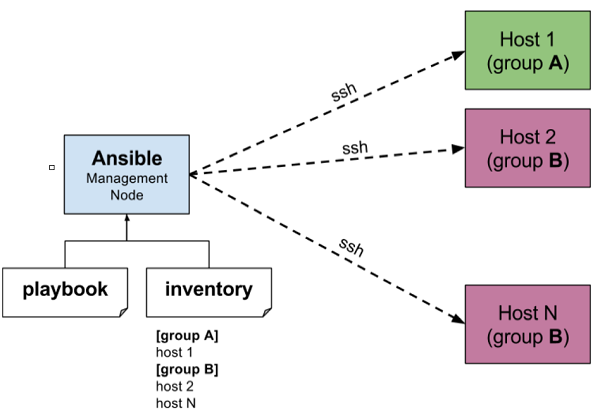Ansible: The Ultimate Guide for Beginners
 ashwini purwat
ashwini purwat
In the ever-evolving world of technology, we often come across terminologies that are pivotal to modern practices but might sound complex to a novice. Two such concepts that every IT professional should be familiar with are Infrastructure as Code (IaC) and Configuration Management. Let’s break down these terms and understand their significance.
Infrastructure as Code (IaC)
What is IaC?
Infrastructure as Code is the practice of defining and managing computer data centers through machine-readable definition files rather than physical hardware configuration. Essentially, IaC treats infrastructure in the same way that software code is treated. This means infrastructure can be shared, reviewed, reused, and versioned.
Why is IaC Important?
Reproducibility: With IaC, an entire infrastructure can be replicated with ease. This ensures consistency across various environments like development, staging, and production.
Version Control: Infrastructure can be versioned. This means that changes to the infrastructure can be tracked and rolled back if necessary, just like with software code.
Automation: IaC allows for automated setup, modification, and deletion of infrastructure components, reducing manual intervention and errors.
Cost Efficiency: Automated infrastructure implies reduced manual labor and quicker turnaround times, saving both time and money.
Configuration Management
What is Configuration Management?
Configuration Management (CM) pertains to the practice of handling changes systematically so that systems maintain their integrity over time. In the context of IT, CM tools help in automating the configuration and deployment of software applications and underlying infrastructure.
Key Benefits of Configuration Management:
- Consistency: CM ensures that configurations are consistent across multiple servers and environments. If you need to run a service or application, you can be sure it has the required system settings, libraries, and files no
matter where it's deployed.
Scalability: Growing an infrastructure often entails adding new servers or components. With CM, scaling becomes a streamlined process. If you have 10 servers or 1000 servers, the process to ensure they’re correctly configured remains the same.
Recovery: Mistakes happen. Systems crash. With Configuration Management, if a system fails or a wrong configuration is applied, it’s much simpler to restore the desired state. CM tools can reapply the correct configurations quickly.
Documentation: CM tools typically maintain a record of system states and configurations. This acts as an automatic documentation process, helping teams understand the setup and changes over time.
Audit and Compliance: For businesses with regulatory and compliance considerations, CM tools provide an audit trail of changes made to configurations, which can be vital for compliance purposes.
How Do IaC and Configuration Management Relate?
Though both IaC and Configuration Management deal with automation and consistency of infrastructure and configurations, they're two sides of the same coin. Here’s how they intertwine:
Foundation and Building: If we use the metaphor of constructing a building, IaC sets up the foundation, structures, and services. CM, on the other hand, ensures that every room in the building is furnished and maintained as per specified standards.
Overlap in Tools: Some tools, like Terraform or CloudFormation, are more IaC-centric, focusing on provisioning infrastructure. Others like Ansible, Puppet, or Chef are more Configuration Management-oriented. However, the lines sometimes blur, and these tools might have overlapping capabilities.
Harmony in Operations: In a DevOps environment, IaC can be used to quickly set up the infrastructure. Once that's in place, CM tools ensure that the systems running on this infrastructure are correctly configured and maintained.
What is Ansible ?
Ansible is an open source IT automation engine that automates provisioning, configuration management, application deployment, orchestration, and many other IT processes. It is free to use, and the project benefits from the experience and intelligence of its thousands of contributors.
How Ansible works ?
Ansible is agentless in nature, which means you don't need install any software on the manage nodes.

It is a push based architecture, i.e if any update comes then ansible push it to all the connected nodes.
For automating Linux and Windows, Ansible connects to managed nodes and pushes out small programs—called Ansible modules—to them. These programs are written to be resource models of the desired state of the system. Ansible then executes these modules (over SSH by default), and removes them when finished. These modules are designed to be idempotent when possible, so that they only make changes to a system when necessary.
For automating network devices and other IT appliances where modules cannot be executed, Ansible runs on the control node. Since Ansible is agentless, it can still communicate with devices without requiring an application or service to be installed on the managed node.
Advantages of Ansible
Ansible is a free and open-source software tool that all can access.
Ansible’s playbooks do not need coding expertise for installation and usage; they are straightforward to configure and use.
Ansible enables the modeling of even the most complex IT processes.
You can orchestrate the whole app environment regardless of where the application is deployed.
It has no agent in the client machines you desire to automate, and one must open no additional software or firewall ports.
Since no extra software is necessary, servers have a greater capacity for app resources, resulting in increased efficiency.
Subscribe to my newsletter
Read articles from ashwini purwat directly inside your inbox. Subscribe to the newsletter, and don't miss out.
Written by
